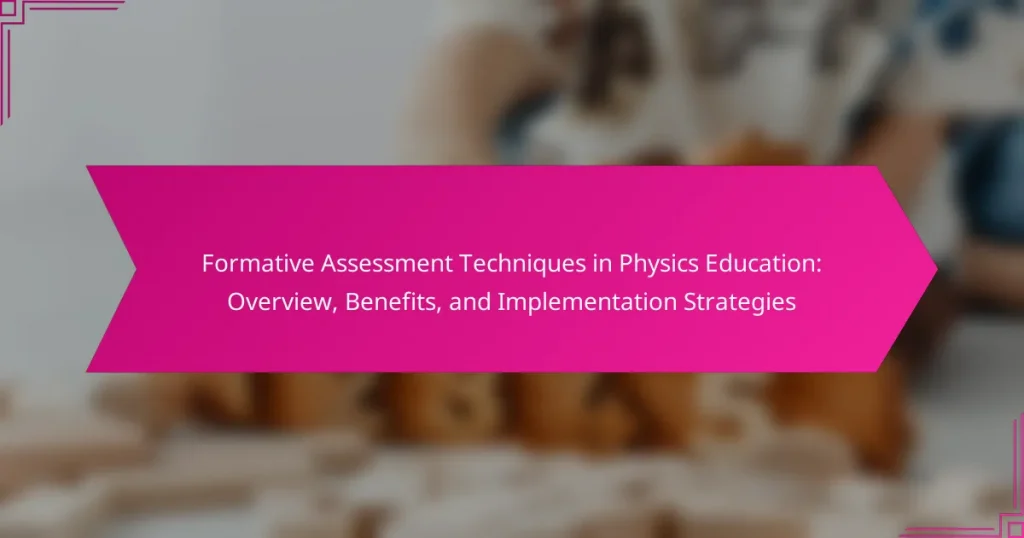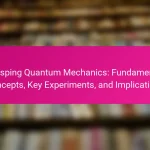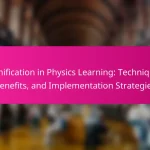Formative assessment techniques in physics education are essential methods designed to monitor and enhance student learning through ongoing feedback. This article explores various techniques such as quizzes, peer assessments, and interactive classroom discussions, highlighting their role in identifying student challenges and informing instructional adjustments. Research indicates that effective implementation of these assessments can significantly improve student understanding and retention of physics concepts, with evidence suggesting performance enhancements of up to 30%. Best practices for integrating these techniques include aligning assessments with learning objectives, utilizing diverse formats, and leveraging technology for real-time feedback, ultimately fostering a more engaging and supportive learning environment.
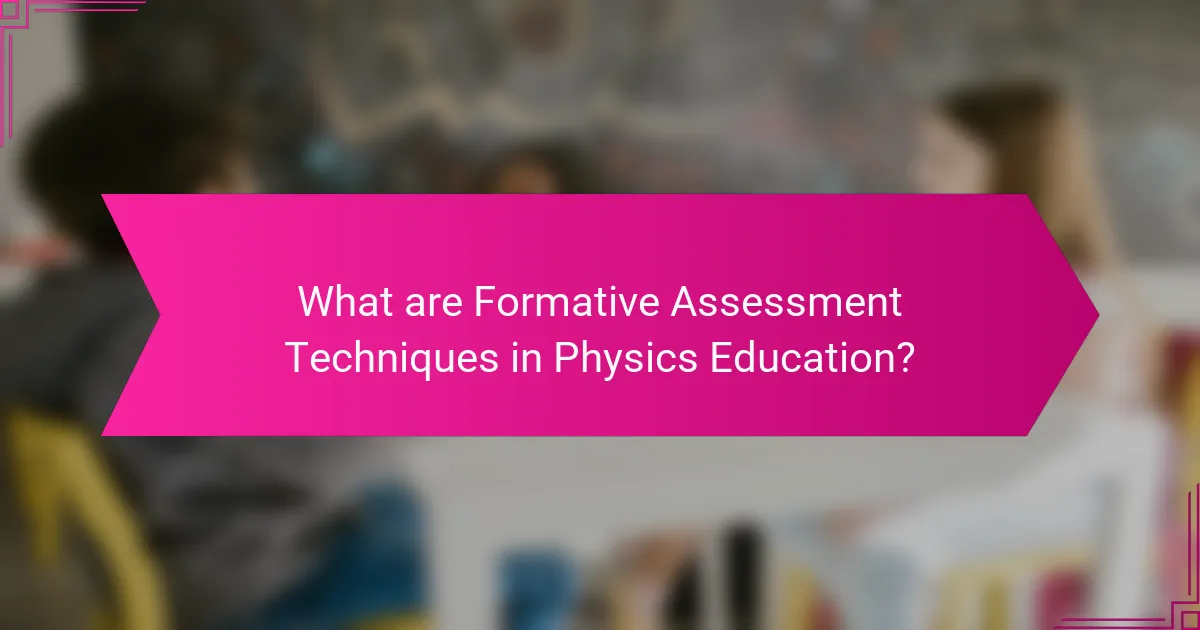
What are Formative Assessment Techniques in Physics Education?
Formative assessment techniques in physics education are methods used to monitor student learning. These techniques provide ongoing feedback to both students and instructors. Common techniques include quizzes, peer assessments, and classroom discussions. They help identify areas where students struggle. This allows educators to adjust their teaching strategies accordingly. Research shows that formative assessments can improve student understanding and retention of physics concepts. For example, a study by Black and Wiliam (1998) found a significant positive impact on learning outcomes when formative assessments were effectively implemented.
How do formative assessment techniques differ from summative assessments?
Formative assessment techniques focus on ongoing feedback during the learning process. They aim to improve student learning and understanding in real-time. Examples include quizzes, discussions, and peer reviews. These assessments help instructors identify areas where students struggle. Summative assessments evaluate student learning at the end of an instructional period. They measure what students have learned through final exams or projects. Formative assessments are diagnostic, while summative assessments are evaluative. Research shows that formative assessments can significantly enhance learning outcomes by providing timely feedback.
What are the key characteristics of formative assessments in physics?
Formative assessments in physics are ongoing evaluations that inform instructional practices. They provide immediate feedback to both students and teachers. These assessments focus on understanding concepts rather than just memorizing facts. They can take various forms, including quizzes, discussions, and hands-on activities. Formative assessments are designed to identify student misconceptions early. They help tailor instruction to meet individual learning needs. Research indicates that formative assessments improve student engagement and learning outcomes. Effective formative assessments encourage self-reflection and peer feedback among students.
Why is formative assessment important in the context of physics education?
Formative assessment is important in physics education because it helps identify students’ understanding and misconceptions. This ongoing evaluation allows educators to adjust their teaching methods accordingly. Research indicates that formative assessment can enhance student engagement and motivation. For example, a study by Black and Wiliam (1998) found that formative assessments significantly improved student learning outcomes. By providing timely feedback, formative assessments guide students in their learning process. Furthermore, they promote self-regulation and metacognitive skills among learners. Overall, formative assessment is a crucial tool for fostering effective physics education.
What types of formative assessment techniques are commonly used in physics education?
Common formative assessment techniques in physics education include quizzes, peer assessments, and concept maps. Quizzes provide immediate feedback on student understanding. Peer assessments encourage collaboration and critical thinking among students. Concept maps help visualize relationships between concepts. Other techniques include think-pair-share, where students discuss problems with peers before sharing with the class. Classroom response systems, or clickers, allow for real-time polling of student understanding during lectures. Additionally, reflective journals encourage students to articulate their learning processes. These techniques foster an interactive learning environment and enhance student engagement.
What are the most effective formative assessment methods for physics?
The most effective formative assessment methods for physics include concept mapping, peer teaching, and classroom response systems. Concept mapping allows students to visualize relationships between concepts. This method promotes deeper understanding of physics topics. Peer teaching encourages collaboration and reinforces knowledge through explanation. Classroom response systems engage students in real-time feedback during lessons. Research indicates that these methods enhance student learning outcomes and retention in physics. For instance, a study by Black and Wiliam (1998) found that formative assessments significantly improve student performance across various subjects, including physics.
How can technology enhance formative assessment techniques in physics?
Technology can enhance formative assessment techniques in physics by providing real-time feedback and interactive learning experiences. Digital tools like clickers and online quizzes allow instant responses during lessons. This immediate feedback helps educators gauge student understanding effectively. Additionally, simulation software facilitates hands-on learning in complex physics concepts. Virtual labs enable students to experiment without physical limitations. Learning management systems track student progress over time. Data analytics can identify learning gaps and tailor instruction accordingly. Research shows that technology integration increases student engagement and improves learning outcomes in physics education.
What are the benefits of implementing formative assessment techniques in physics education?
Implementing formative assessment techniques in physics education enhances student learning and engagement. These techniques provide immediate feedback, allowing students to identify their strengths and weaknesses. Research shows that formative assessments can improve academic performance by up to 25%. They also promote active learning, encouraging students to take responsibility for their own learning. Furthermore, formative assessments foster a growth mindset, as students learn from mistakes and adjust their strategies. This iterative process helps deepen understanding of complex physics concepts. Overall, formative assessment techniques contribute significantly to a more effective and responsive educational environment in physics.
How do formative assessments improve student learning outcomes in physics?
Formative assessments improve student learning outcomes in physics by providing ongoing feedback and opportunities for self-assessment. They help identify students’ misconceptions early in the learning process. This allows educators to adjust their teaching strategies accordingly. Research indicates that formative assessments can lead to a 20% increase in student performance. For example, a study by Black and Wiliam (1998) found that effective formative assessment practices significantly enhance student engagement and understanding. By fostering a growth mindset, formative assessments encourage students to take ownership of their learning. This approach leads to deeper comprehension of complex physics concepts.
What impact do formative assessments have on teacher instruction in physics?
Formative assessments significantly enhance teacher instruction in physics. They provide real-time feedback on student understanding. This feedback allows teachers to adjust their teaching strategies accordingly. For instance, if many students struggle with a concept, the teacher can revisit that topic. Research shows that formative assessments lead to improved student performance. A study by Black and Wiliam (1998) found that effective formative assessment can raise achievement levels by as much as 30%. Teachers who utilize formative assessments can create a more responsive learning environment. This adaptability ultimately fosters deeper student engagement in physics.
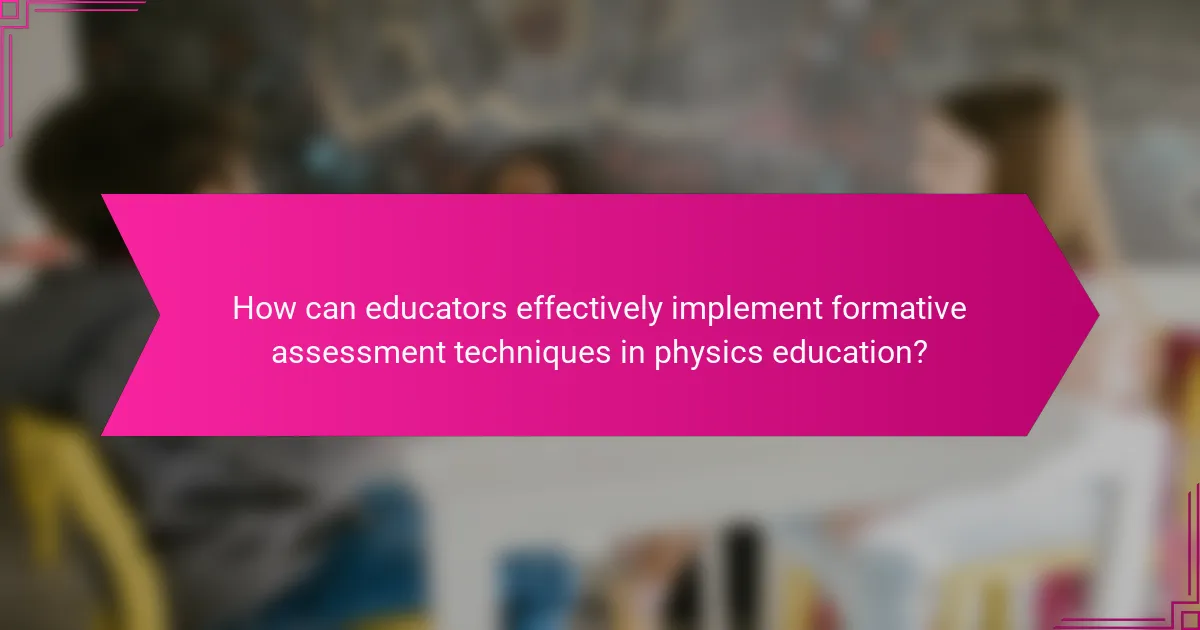
How can educators effectively implement formative assessment techniques in physics education?
Educators can effectively implement formative assessment techniques in physics education by integrating regular feedback mechanisms into their teaching practices. These can include quizzes, peer assessments, and interactive classroom activities. Regular quizzes help gauge student understanding and inform instructional adjustments. Peer assessments encourage collaboration and critical thinking among students. Interactive activities, such as think-pair-share, promote engagement and immediate feedback. Research indicates that formative assessments can improve student performance by up to 30% when used consistently. Additionally, utilizing technology, such as online polling tools, can facilitate real-time feedback and increase participation.
What strategies can teachers use to integrate formative assessments into their physics curriculum?
Teachers can integrate formative assessments into their physics curriculum by using various strategies. One effective strategy is implementing regular quizzes that assess student understanding of key concepts. These quizzes can be low-stakes, encouraging students to engage without the pressure of high-stakes testing. Another approach is using peer assessments, where students evaluate each other’s work. This fosters collaboration and deeper understanding of the material.
Additionally, teachers can incorporate exit tickets at the end of each class. These quick reflections allow students to summarize what they learned and identify areas of confusion. Concept maps are also useful for visualizing relationships between topics. They help students organize their thoughts and demonstrate their understanding.
Moreover, interactive classroom activities, such as think-pair-share, promote discussion and immediate feedback. Utilizing technology, such as online polling tools, can gauge student comprehension in real-time. Finally, providing timely, specific feedback on assignments helps students understand their progress and areas needing improvement. These strategies collectively enhance learning and provide valuable insights into student understanding.
How can educators design effective formative assessment activities for physics?
Educators can design effective formative assessment activities for physics by incorporating diverse strategies that engage students. One effective method is using concept maps to visualize relationships between physics concepts. This allows students to demonstrate their understanding and identify misconceptions. Another strategy is implementing peer assessments, where students evaluate each other’s work, fostering collaboration and critical thinking.
Educators can also use interactive quizzes to assess student knowledge in real-time. Tools like Kahoot or Quizizz can provide immediate feedback. Additionally, educators should incorporate hands-on experiments that require students to apply theoretical knowledge practically. This experiential learning solidifies understanding.
Furthermore, educators can utilize reflective journals where students articulate their learning process. This encourages metacognition and self-assessment. Regular check-ins through exit tickets can help gauge student comprehension at the end of a lesson. Overall, a combination of these strategies can create a comprehensive formative assessment framework in physics education.
What role does feedback play in the implementation of formative assessments?
Feedback is crucial in the implementation of formative assessments. It provides learners with specific information about their performance. This guidance helps students identify their strengths and areas for improvement. Timely feedback can enhance motivation and engagement in the learning process. Research shows that effective feedback can lead to increased student achievement. For instance, Hattie and Timperley (2007) found that feedback is one of the most powerful influences on learning outcomes. By addressing misconceptions, feedback allows for adjustments in teaching strategies. Overall, feedback is an integral component that shapes the effectiveness of formative assessments.
What challenges might educators face when implementing formative assessment techniques?
Educators face several challenges when implementing formative assessment techniques. One major challenge is the lack of time for both planning and conducting assessments. Research indicates that teachers often feel overwhelmed by their existing responsibilities. Additionally, educators may struggle with insufficient training in formative assessment methods. This lack of training can lead to ineffective implementation. Another challenge is the potential resistance from students. Some students may not understand the purpose of formative assessments. Furthermore, educators may encounter difficulties in providing timely and constructive feedback. This is crucial for the effectiveness of formative assessments. Lastly, aligning formative assessments with curriculum standards can be complex. This alignment is necessary to ensure that assessments are relevant and meaningful.
How can teachers overcome common barriers to effective formative assessment?
Teachers can overcome common barriers to effective formative assessment by implementing structured feedback mechanisms. They can establish clear learning objectives to guide assessments. Regular training on assessment strategies can enhance teachers’ skills. Utilizing technology can streamline assessment processes and data collection. Collaboration among teachers fosters sharing of best practices. Engaging students in self-assessment promotes ownership of their learning. Research indicates that formative assessment improves student outcomes when effectively applied. For instance, a study by Black and Wiliam (1998) found that formative assessment can significantly enhance student achievement across various subjects.
What resources are available to support educators in using formative assessments?
Resources available to support educators in using formative assessments include professional development workshops, online courses, and educational websites. Workshops provide hands-on experience and strategies for effective assessment techniques. Online courses offer flexibility and a wide range of topics related to formative assessments. Educational websites, such as the Assessment Institute and the National Council of Teachers of Mathematics, provide valuable tools and resources. Additionally, research articles, such as “Formative Assessment in the Classroom” by Black and Wiliam, highlight effective practices and methodologies. These resources collectively enhance educators’ understanding and implementation of formative assessments in the classroom.
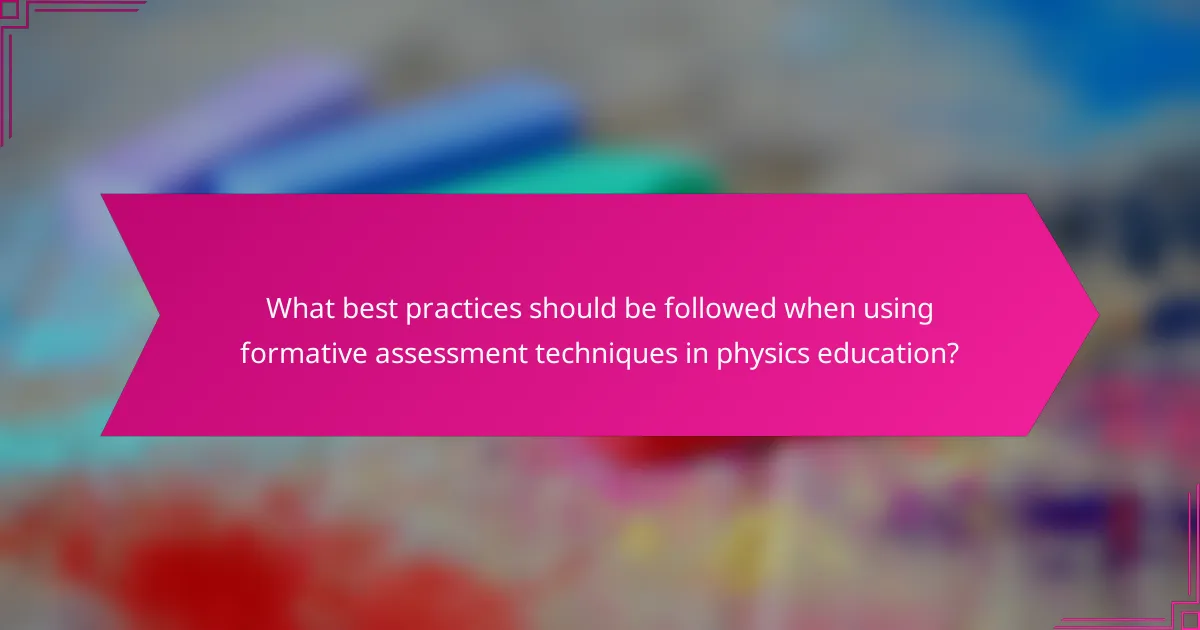
What best practices should be followed when using formative assessment techniques in physics education?
Best practices for using formative assessment techniques in physics education include aligning assessments with learning objectives. This ensures that assessments accurately measure student understanding of key concepts. Frequent and low-stakes assessments help to reduce student anxiety and encourage ongoing feedback. Incorporating diverse assessment formats, such as quizzes, peer assessments, and concept maps, caters to different learning styles. Providing timely feedback allows students to reflect on their learning and make necessary adjustments. Engaging students in self-assessment promotes metacognition and ownership of their learning process. Lastly, utilizing technology can streamline data collection and analysis, enhancing the overall assessment experience.
How can teachers ensure that formative assessments are aligned with learning objectives?
Teachers can ensure formative assessments are aligned with learning objectives by clearly defining those objectives first. They should develop assessments that specifically measure the skills and knowledge outlined in the objectives. Regularly reviewing and revising assessments based on student performance is crucial. This practice helps identify gaps in alignment. Additionally, using rubrics that reflect learning objectives can provide clear criteria for evaluation. Incorporating student feedback can also guide alignment efforts. Research shows that alignment increases student understanding and achievement. Studies indicate that aligned assessments lead to improved educational outcomes in various subjects, including physics.
What tips can educators use to effectively analyze formative assessment data?
Educators can effectively analyze formative assessment data by employing several strategies. First, they should categorize data based on learning objectives. This helps in identifying specific areas where students struggle. Next, using visual representations like charts or graphs can clarify trends in student performance. This method enhances understanding of collective learning patterns.
Additionally, collaborating with colleagues to discuss findings can provide diverse perspectives. Such collaboration can lead to more comprehensive insights. Regularly revisiting and adjusting assessment methods based on data analysis ensures continuous improvement. This adaptability is essential for addressing evolving student needs.
Lastly, utilizing feedback loops by sharing data with students fosters a growth mindset. This encourages students to take ownership of their learning. Evidence suggests that these practices enhance the effectiveness of formative assessments in educational settings.
How can educators foster a growth mindset through formative assessments?
Educators can foster a growth mindset through formative assessments by providing timely and constructive feedback. This feedback encourages students to view challenges as opportunities for growth. Formative assessments can include quizzes, peer reviews, and reflective journals. These methods allow educators to gauge student understanding and adapt instruction accordingly. Research shows that timely feedback can improve student motivation and performance. For example, a study by Hattie and Timperley (2007) highlights the significant impact of feedback on learning outcomes. By emphasizing effort and progress, educators can help students develop resilience and a positive attitude toward learning.
What are some practical examples of formative assessment techniques in physics education?
Practical examples of formative assessment techniques in physics education include concept maps, peer teaching, and interactive quizzes. Concept maps allow students to visually organize their understanding of physics concepts. Peer teaching involves students explaining concepts to each other, enhancing comprehension. Interactive quizzes provide immediate feedback on student understanding. Other techniques include think-pair-share activities and exit tickets, which gauge student learning at the end of a lesson. These methods encourage active engagement and facilitate ongoing assessment of student progress.
How can peer assessment be utilized in physics classrooms?
Peer assessment can be utilized in physics classrooms to enhance student learning and engagement. It allows students to evaluate each other’s work, fostering a collaborative learning environment. This method encourages critical thinking as students must analyze and provide constructive feedback. Research shows that peer assessment can improve understanding of physics concepts. Additionally, it helps students develop communication skills by articulating their thoughts clearly. Implementing peer assessment can lead to increased motivation among students. A study by Topping (1998) highlights that peer assessment can enhance academic performance and self-regulation. Overall, peer assessment serves as a valuable formative assessment tool in physics education.
What role do self-assessments play in enhancing student understanding in physics?
Self-assessments enhance student understanding in physics by promoting reflection on learning processes. They encourage students to evaluate their comprehension and identify areas needing improvement. This active engagement helps solidify knowledge and fosters metacognitive skills. Research shows that self-assessments can lead to improved academic performance. A study published in the “Journal of College Science Teaching” found that students who engaged in self-assessment scored higher on physics exams. This indicates that self-assessment can effectively bridge gaps in understanding and enhance overall learning outcomes in physics.
Formative assessment techniques in physics education are essential methods employed to monitor and enhance student learning through ongoing feedback. This article provides an overview of various formative assessment methods, such as quizzes, peer assessments, and interactive activities, highlighting their importance in identifying student misconceptions and improving engagement. It discusses the differences between formative and summative assessments, the key characteristics and benefits of formative assessments, and effective implementation strategies for educators. Additionally, the article addresses challenges faced by teachers and offers resources and best practices for integrating formative assessments into the physics curriculum.
